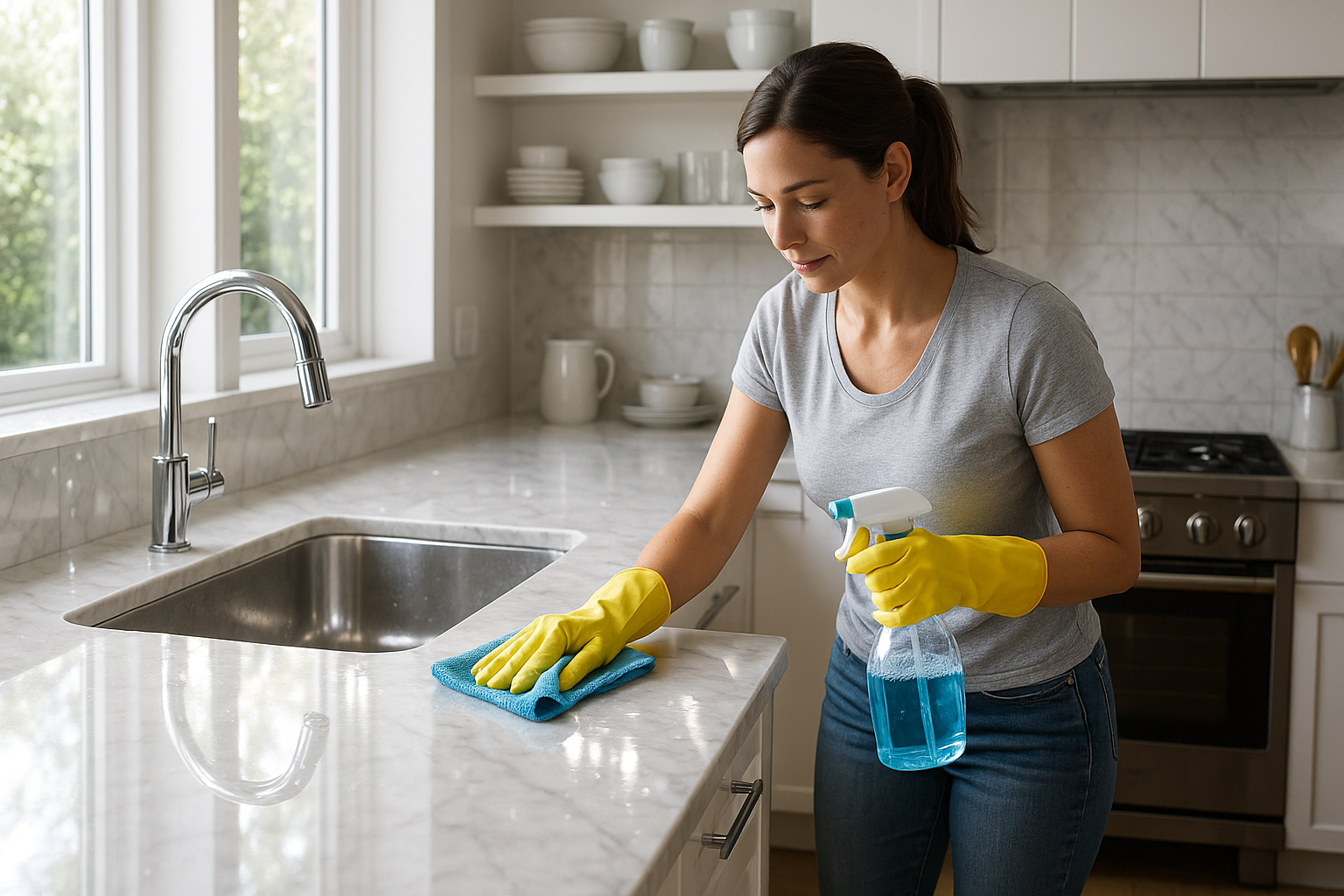Whether it’s the gleaming tiles in your kitchen, the dust-free surface of your office desk, or the pristine interior of your car, a clean space not only looks inviting, but it also contributes to your overall wellbeing. For some, the art of cleaning is therapeutic, a meditative activity that brings a sense of accomplishment. For others, it may be a necessary chore, but not particularly enjoyable. Regardless of which category you fall into, this ultimate guide to a spotless clean-up routine will be an invaluable resource. 📘
Imagine walking into a room that is not only clean but sparkling, where every surface gleams and each corner is free of dust. A place where every item is in its designated place, creating an environment of order and tranquillity. This is not a figment of your imagination or a scene from a glossy magazine; it’s a reality that can be achieved with the right cleaning routine.
So, what makes a cleaning routine ‘right’? Is it the cleaning products you use? The time you allocate for cleaning? Or maybe it’s the order in which you clean? The answer is all of the above and more! It’s a combination of the right techniques, tools, timing, and tenacity. And that’s precisely what we’ll delve into in this guide.
The Art of Cleaning – More than meets the eye
Cleaning is more than just a task; it’s a science and an art. It involves understanding the properties of different materials, the chemical reactions of cleaning products, and the most effective techniques to remove dirt, dust, and grime. It requires patience, attention to detail, and a willingness to learn and adapt. 💡
This guide is designed for anyone who wants to elevate their cleaning routine, whether you’re a cleaning enthusiast looking to refine your skills or a busy professional seeking to make the most of your limited cleaning time. We’ll start with a deep dive into the chemistry of cleaning, exploring how different cleaning agents interact with various types of dirt and surfaces.
Product Selection – Your Cleaning Arsenal
Next, we will look into the importance of choosing the right cleaning products. From eco-friendly alternatives to heavy-duty industrial cleaners, the market is flooded with options. This section will help you decipher the complex jargon on product labels and guide you in selecting the best cleaning agents for your specific needs. A well-chosen product can be the difference between a tiresome scrubbing session and a quick, effortless clean. 🧹
Time and Techniques – Perfecting Your Routine
Time is a crucial factor in cleaning, but it’s not just about speed. It’s about efficiency. In the section on time and techniques, we’ll look at how to plan your cleaning routine, order your tasks for maximum efficiency, and utilize techniques that will save you time and effort without compromising on the quality of your clean.
This guide aims to provide a comprehensive, easy-to-understand resource that simplifies the science of cleaning, offers practical advice, and encourages you to find joy in the process of creating a clean, sparkling environment. 🌟 So, let’s roll up our sleeves and dive into the fascinating world of spotless clean-up routines!
Sparkle and Shine: Deciphering the Basics
When it comes to maintaining a spotless environment, understanding the basics is pivotal. In this era where cleanliness has become a high priority, knowledge about the fundamentals of effective clean-up is not only helpful but also essential. Let’s delve into the science of cleaning, unraveling the key principles that ensure a flawless clean-up routine.
Cleaning, in its simplest form, is the process of removing unwanted substances, such as dirt, infectious agents, and other impurities, from an object or environment. While it may seem like a mundane task, a thorough understanding of the different types of cleaning agents, their properties, and their usage can immensely enhance the efficiency of your cleaning routine.
By grasping the importance of factors such as pH levels in detergents, the role of solvents, and the significance of temperature in cleaning, you can make informed decisions in choosing the right products and methods for different cleaning tasks. To help you better understand this, let’s take a closer look at the different types of cleaning agents in the table below.
| Type of Cleaning Agent | Properties | Usage |
| Detergents | Alkaline in nature, Removes grease and oils | Kitchen surfaces, dishes, clothes |
| Disinfectants | Kills microorganisms, Does not necessarily clean dirty surfaces | High-touch areas like door knobs, toilet seats |
| Acid Cleaners | Removes hard water deposits, rust stains, and tarnish | Bathroom fixtures, descaling appliances |
Unleashing the Power of Cleaning Tools
Equally significant as the cleaning agents are the cleaning tools. Every tool has a specific purpose, and using the right tool can enhance your cleaning routine’s effectiveness. For instance, a scrub brush with stiff bristles is ideal for heavy-duty cleaning tasks, while a microfiber cloth is perfect for dusting and polishing.
Apart from these, modern technology has provided us with an array of innovative tools designed to make cleaning easier and more efficient. From robotic vacuum cleaners to steam mops, the world of cleaning tools is vast and dynamic. A comparison of some of the most common cleaning tools and their uses is outlined in the table below.
| Tool | Usage |
| Microfiber Cloth | Dusting, polishing, wiping surfaces |
| Scrub Brush | Heavy-duty cleaning tasks |
| Robotic Vacuum Cleaner | Cleaning floors without manual effort |
| Steam Mop | Cleaning and disinfecting hard floors |
To explore this topic further, you can watch the video “Top 10 Cleaning Gadgets on Amazon” by the YouTube channel TechJoint.
Maintaining a Consistent Cleaning Routine
While understanding the science of cleaning and utilizing the right tools is vital, none of it will yield significant results without a consistent and well-structured cleaning routine. A consistent cleaning schedule not only ensures that your environment stays clean and tidy but also reduces the overall time and effort spent on cleaning.
To establish a cleaning routine, start by listing out all the cleaning tasks required for your environment. This list should include daily tasks such as washing dishes and sweeping floors, weekly tasks like laundry and bathroom cleaning, and monthly tasks such as deep-cleaning appliances. Once you have your list, allocate specific time slots for each task based on your availability and preference.
Remember, the key to a successful cleaning routine is consistency. To maintain this, try to make cleaning a habit rather than a chore. Incorporating small cleaning tasks into your daily routine, like wiping down kitchen surfaces after cooking or making your bed first thing in the morning, can make a significant difference. To assist you in creating your cleaning schedule, you can refer to the video “How to Create a Cleaning Schedule That Works for You” by Clean My Space on YouTube.
Embracing Eco-Friendly Cleaning
As we strive to keep our environments clean, it’s equally important to consider the impact of our actions on the environment. Traditional cleaning products often contain chemicals that can be harmful to both us and the environment. Switching to eco-friendly cleaning products not only reduces these risks but also contributes towards a sustainable future.
Eco-friendly cleaning products are made using natural ingredients that are safe for us and the environment. They are biodegradable, non-toxic, and often come in recyclable packaging. Some popular eco-friendly cleaning brands include Seventh Generation, Mrs. Meyer’s Clean Day, and Ecover.
Moreover, embracing eco-friendly cleaning doesn’t necessarily mean purchasing expensive products. Many effective cleaning solutions can be made at home using everyday ingredients such as vinegar, baking soda, and lemon. For instance, a mixture of vinegar and water can be an excellent solution for cleaning windows and mirrors. The video “10 Eco-Friendly DIY Cleaning Solutions” by Goodful on YouTube provides several such homemade cleaning solution recipes.
The Magic of Organizing
The final piece of the puzzle in achieving a spotless environment is organization. A clean but disorganized space can still appear cluttered and messy. Therefore, effective organizing strategies are essential to maintain a tidy environment.
Organizing involves arranging items in a systematic way that makes it easy to find and use them. This can be achieved through various methods, such as categorizing, labeling, and using storage solutions. For instance, kitchen items can be categorized into groups like baking, cooking, and serving, and then stored in separate cabinets or shelves.
Similarly, clutter can be significantly reduced by following the “one in, one out” rule, where for every new item you bring into your home, you get rid of another. Another effective strategy is the “do it now” rule, where you deal with tasks immediately rather than postponing them. This prevents the accumulation of clutter over time. For more ideas on organizing, you can watch the video “10 Habits for a Well-Organized Home” by VasseurBeauty on YouTube.
By implementing these principles in your cleaning routine, you can achieve a spotless environment that truly sparkles and shines. Remember, cleaning is not a one-time task, but a continuous process. With the right knowledge, tools, and consistency, maintaining a clean and tidy environment can become a rewarding and fulfilling endeavor.

Conclusion
In the technical realm of Information Technology and Software Engineering, we’ve reached the end of our comprehensive discussion, having explored some profound concepts and emerging trends. We can’t emphasize enough that understanding these concepts can offer tremendous leverage in your profession or business.
Starting from the initial point, we dove deep into the intricate details of software development methodologies, unraveling the hidden gems within Agile and DevOps frameworks. We highlighted how these frameworks not only accelerate the software development process but also amplify the overall productivity and efficiency of an organization.
We then took a trip around the cutting-edge technologies, like Artificial Intelligence (AI), Machine Learning (ML), and Blockchain. It was compelling to see how these technologies are not only disrupting the traditional IT landscape but also opening up a world of endless possibilities. We hope you could see that these are not just trendy buzzwords, but real, tangible technologies that are transforming our lives and businesses.
Furthermore, we took the liberty to discuss the importance of cybersecurity, emphasizing its necessity in this digital age. With the increasing number of cyber threats, the need for robust security measures, and ethical hacking has never been more critical.
Lastly, we explored the world of cloud computing, showcasing its benefits, from cost-effectiveness to scalability and accessibility.
The world of IT and Software Engineering is evolving at an unprecedented pace, and being a part of it requires an insatiable thirst for knowledge and an unwavering passion for innovation.💡
We hope you found the insights shared in this article valuable and inspiring. Please, feel free to share your thoughts in the comment section, and don’t hesitate to share this knowledge with others. Remember, knowledge increases by sharing but diminishes by keeping.
Let’s continue the conversation on our social media platforms. Be sure to follow us for more updates on the latest trends and insights in the world of IT and Software Engineering.
If you’re keen on diving deeper into these topics, here are a few resources you might find useful:
1. [Agile Software Development](https://www.agilealliance.org/agile101/)
2. [DevOps: A Beginner’s Guide](https://www.ibm.com/cloud/learn/devops-a-complete-guide)
3. [AI, Machine Learning, and Deep Learning](https://www.nvidia.com/en-us/deep-learning-ai/education/)
4. [Introduction to Blockchain Technology](https://www.ibm.com/topics/what-is-blockchain)
5. [Cybersecurity: An Introduction](https://www.us-cert.gov/ncas/tips/ST04-001)
6. [Cloud Computing Explained](https://www.ibm.com/cloud/learn/what-is-cloud-computing)
Remember, the journey of learning never ends. It is an ongoing process that requires continuous effort. So, stay curious, keep learning, and don’t be afraid to explore new horizons.
In the words of Dr. Seuss, “The more that you read, the more things you will know. The more that you learn, the more places you’ll go.” 🚀
Until next time, stay safe, and keep innovating!
Tags: #IT #SoftwareEngineering #Agile #DevOps #AI #ML #Blockchain #Cybersecurity #CloudComputing



